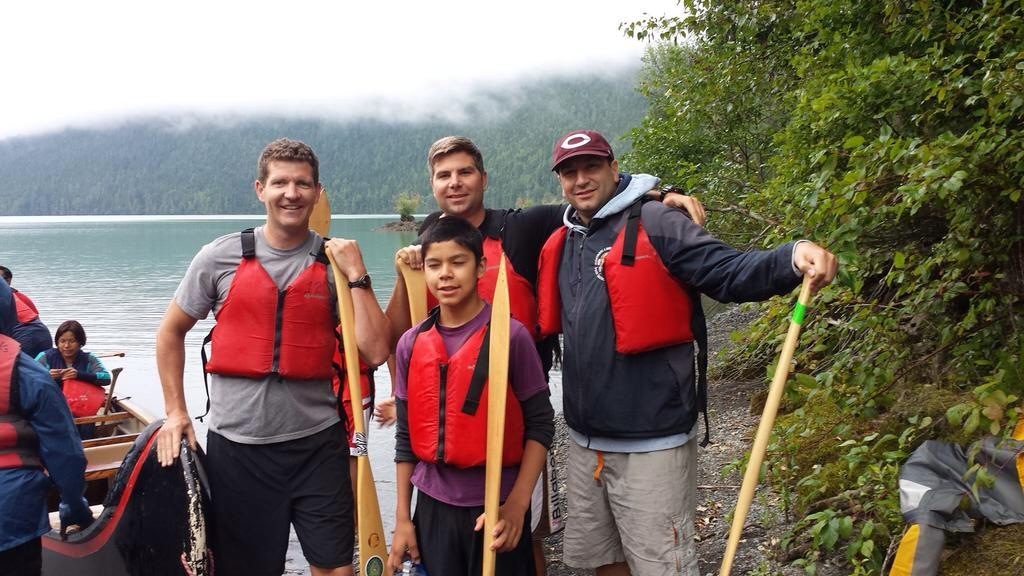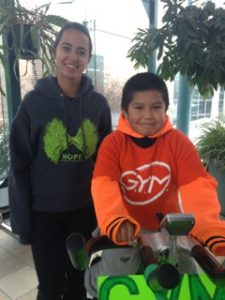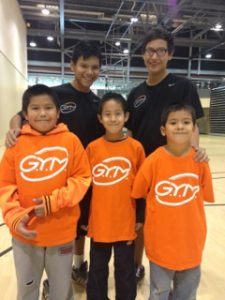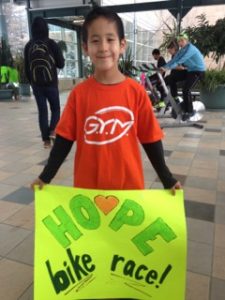Community-based research is unique because it is not just research—It’s about developing relationships and transforming lives. Commitments are long-term and indefinite, and the research must be a secondary concern. Such is the case for three researchers, Brian Lewis, Dr. Sean Lessard, and Dr. Lee Schaefer, who are involved in the development of and research with Growing Young Movers (GYM), an after school program dedicated to the social, emotional, and physical development of children and youth from North Central Regina.
Brian Lewis, a doctoral candidate in the Faculty of Education, and a past Physical Education/Health Consultant for Regina Catholic School Division, had a vision for after school programming for youth around movement, wellness, and physical education. When Lewis first met Schaefer and Lessard, professors in the Faculty of Education, he was looking to do further programming. “I was trying to run programs that looked different than the typical sport programs, than the ones I had seen as an educator,” he says. The three began informally discussing the need they saw for after school programming that would reach students who may have less access to competitive sports, and who may not have the opportunity to participate in such a program. “We began talking about the possibility of creating a space where we could connect with a community and research alongside that community,” says Lessard
“There was good symmetry between us,” says Lessard. “I was new to Regina, and had acquired funding that could be directed towards a new program. Brian is unbelievably skilled in terms of working within programming…as soon as Brian started asking, ‘What about all the other kids that don’t get a chance to participate?’, I was 100% in,” says Lessard.
Lessard’s strength is in working with communities and Aboriginal youth as well as advocating for funding, and Schaefer offers his expertise in the research process. “Lee is our methodologist; he keeps us on track, works on data collection and administrating the project,” says Lessard. Schaefer’s interest in movement and physical literacy complements Lewis’s interest. Schaefer also brings to the program his connection to the Faculty of Education’s Health Outdoor Physical Education (HOPE) student association for which he is faculty liaison. Through this connection, GYM has access to university students who are interested in volunteering their time to work with the program. HOPE students have also assisted the GYM program through a variety of fundraisers, which have provided equipment and resources to the program, including the purchase of running shoes for each of the students in the GYM.
“We could also agree on the methodology for the research,” says Lessard. The research methods are a mix of indigenous methodology and narrative inquiry, qualitative methods that allow the research to grow slowly out of relationship with the participants. “We do not study kids; we listen to them tell their stories, sharing experiences about life in this space we’ve created with them,” says Lessard. However, when applying for a grant or ethics approval, researchers are required to plan their research in a prescriptive manner. It is necessary to be specific, to say for instance, “I’m interviewing three students.” In fact, says Lewis, “the students pick the researcher—it’s the reverse.”
Out of these discussions, the Growing Young Movers (GYM) after school program began. GYM has adopted parts of the Teaching Personal and Social Responsibility model for delivering the Saskatchewan physical education curriculum. The program focuses on “movement” rather than sports, not only to reach kids who are not in competitive sports, but also because movement is a concept that extends into all aspects of life. In thinking about movement and wellness, “think healing,” says Lessard. “Wellness is a huge piece for us.” Schaefer adds, “Physical Education (PE) programming at the U of R promotes teaching PE conceptually because it allows for a transfer into a variety of activities, not just a specific sport.”
Moving well together is what the team hopes youth will learn from the program. For example, whenever the youth have an excursion, they ask themselves, “How are we doing?” Moving well on an excursion means, for example, moving well as they line up for and board the bus. GYM meets every Wednesday after school from September to June, usually in the gymnasium of Kitchener Community School. The youth participate in wellness and physical activities, which promote the idea of moving well together. “One of the games we do not play is dodge ball,” says Lewis. “Our activities are thought through,” says Lessard; “they promote personal and social responsibility.” Lewis adds, “I know when new youth come to the program and ask to play dodge ball and the other kids respond, ‘We don’t play dodge ball,’ that’s when we know we are doing things differently.” Lessard highlights one of Lewis’s points regarding gymnasiums as “spaces where some of the best things happen and some of the worst…” Lessard continues, “In this program, through the space of a gymnasium, we learn to move in healthy ways—it’s a metaphor—learning to move in a different way in the community…moving well with one another.”
Mentors are an important part of GYM programming, especially as the researchers consider the future of the program. Schaefer says, “The intergenerational piece is part of the program; we involve Grade 8 and high school students who participate in the program, but are also responsible for mentoring the younger students and facilitating activities. We also include university student mentors, many of whom are a part of the Faculty of Education.” Developing junior high, high school, and university student mentors, “is the capacity building piece,” says Lessard. Because of their involvement, mentors have become fully capable of running the program. “We now have five high school mentors that once attended Kitchener School and our program; we also have Grades 3 and 4 students coming back to us a junior high mentors…they are dynamic in working with each other,” says Lewis. In the spirit of moving well, mentors are paid well through funding, and for some of them, it is their first job experience.
Community-based research is not for the faint of heart. “It’s messy,” says Lessard. “It is much more than research; it means a long-term, indefinite commitment.” Lewis agrees, “This was not going to be a fly in, drop in, leave research model…We wanted to take the time to get to know the needs of the community…You can’t build relationships with a one-day-a-week-for-six-weeks type model.” Lessard adds, “We are letting the needs define the research.” Schaefer explains, “It is not about us identifying needs of the community as researchers, but about building relationships with community so that they have autonomy over identifying what they think is needed. So it’s not that the researchers have the answers; it’s much more about gaining an understanding together.” This can make the formal research process complicated. Lessard points out that ethics approval for research and grant proposals for funding are incongruent with community-based research, “They have a prescriptive approach that narrows down the research,” he says. But when working with the program they make research a secondary concern, and because the youth are shaping the research, it is emerging and growing organically.
Now in Year 3 of the project, the researchers are seeing the results of their efforts blossoming, with some mentors ready to take on programming, research conversations ongoing, charts of articles and topics for research developing, and attendance in the GYM program growing. “We know there is this magic happening,” says Lessard. One of the aspects the researchers are interested in is the liminal space within which GYM operates. “This space is not a school institution or home…We are asking how does this in-between space shape both worlds: home and school,” says Lessard.
There are connections and partnerships developing out of this program. Lessard says, “We try to surround ourselves with good people.. such as the File Hills Qu’Appelle Tribal Council and Treaty 4 Urban Aboriginal Youth who have taken care of us. The program just keeps evolving.”
“We are being asked by places across Western Canada to talk about [the program]. We are invited to different places to demonstrate healing through movement with their students. New relationships have started to grow, such as with Changemakers and Indspire Institute,” says Lessard.
With new connections developing, the researchers are aware that new opportunities are also taking shape. Still, with all of these interesting developments, what matters most is the work with the Growing Young Movers, and the transformations that they are seeing as the youth learn to move well together.
Tune in at 8:15 am Wednesday, October 7 to meet some of the great kids involved in the G.Y.M. program. 102.5FM CBC Radio
GYM: Growing Young Movers (White Bear member) from Wikiupedia on Vimeo.
GYM: Growing Young Movers from Wikiupedia on Vimeo.



